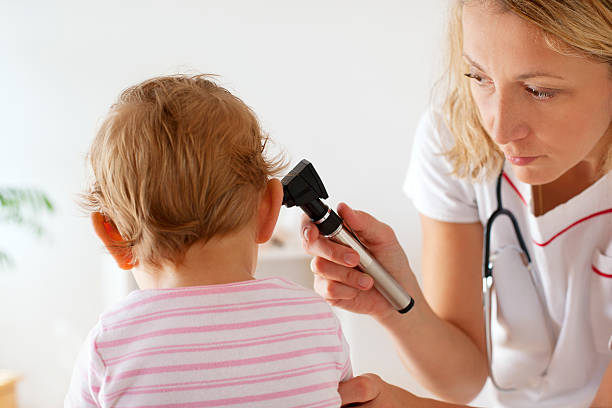A toddler is a child who is 12 months to 36 months old. While some toddlers can point out and say, “My ear hurts”, many toddlers cannot.
Therefore you as parents should know how to identify whether your toddler is suffering from an ear infection. Ear infections are commonly seen in toddlers than adults and older children.
The toddlers and infants are more prone to ear infections than adults because of their undeveloped immune system and the shape of their Eustachian tubes.
The eustachian tube is the narrow tube that runs from each middle ear, behind the nasal passages to high in the back of the throat. The throat end of the Eustachian tube opens and closes to regulate the air pressure in the middle ear, to refresh air within the ear, and to drain normal secretions of the middle ear via the throat.
When the Eustachian tubes are swollen, they can get blocked. This leads to build-up of fluid inside the middle ear. When this fluid cannot drain, it usually can get infected, giving rise to signs of an ear infection.
The Eustachian tubes in toddlers are narrower and more horizontal. Therefore it is more difficult to drain and is more likely to get clogged.
When there is a cold, the adenoids (two small pads of tissues situated high in the back of the nose) become swollen. Swelling and irritation of adenoids can block the Eustachian tubes as they are situated nearby. In toddlers, the adenoids are relatively larger compared to those of adults. This will contribute more towards ear infections in toddlers.
What is an ear infection?
An ear infection is also known as acute Ottitis Media, which means the middle ear is infected with a bacteria or a virus. The middle ear is the air-filled space behind the eardrum. It can get infected whenever there is a sore throat, and a cold as the middle ear is connected to the throat and nasal passages. Therefore germs can pass to the middle ear causing infections.
Ear infections can also occur when there is a sinus infection or an allergy. These are the causes that can lead to congestion and swelling of nasal passages, Eustachian tubes, and throat, in turn causing ear infections.
It is a well- known fact that children suffer from ear infections more than adults. The signs of ear infection will also differ between the two groups, as adults can correctly identify the problem is with the ear due to the earache and possible discharge. However, toddlers may show different signs, and most of the time, these signs may be vague.
Therefore you should be sharp enough to catch those signs early so that medical attention can be sought early. If ear infections are not identified on time and treated, your toddler can develop serious complications like hearing loss, perforation of the eardrum, inflammation of the bones adjacent to the ear (mastoiditis), inflammation of meninges of the brain and spinal cord (meningitis) or even paralysis of the facial nerve.
Although these complications are rare from a single ear infection, it not impossible. Therefore it is crucial to identify the signs of ear infection early so that treatment can be started early to prevent further complications.
What are the signs that point towards a possible ear infection in your toddler?
If your toddler is old enough to communicate, he or she can tell you about an aching ear. This will help you towards looking for other signs such as redness, a possible discharge, etc. Ear pain can also occur when the toddler is teething or if an insect has gone inside the ear canal.
If you are not sure why your toddler is complaining of earache, it is better to seek help, as your doctor will examine your toddler’s ears and correctly identify the reason for the pain and treat accordingly.
Unfortunately, most toddlers cannot precisely tell what is wrong with them. They may not be old enough to complain; therefore, knowing these signs will come in handy and will help you to suspect a possible ear infection.
Fever –

Fever is body temperature, which is higher than normal. The average body temperature in a toddler is 98.6 Fahrenheit or 37 degrees Celsius. A raised body temperature of 100 F or 38 C or higher will be a good sign to suspect any kind of infection.
Fever can occur when your body is trying hard to fight an infection or an illness. When there is an ear infection, your toddler’s immune system will fight hard with the germ. During this time, fever can arise as a sign. However, fever may not always be present in an ear infection.
Not having a fever does not exclude an ear infection, and having a fever may not always point towards an ear infection. However, fever is a common sign mainly found in infants and younger children with an ear infection.
You may suspect fever when your toddler is unusually warm to touch. It is good to have a thermometer at home because then you can measure the temperature and come to the conclusion that your toddler is indeed having fever rather than just staying in suspicion.
Tugging or pulling at the ear or ears –
You may notice that your toddler is unusually tugging at one or both ears. Sometimes he or she may tilt the head to one side. As ear infection cause pain and discomfort, your toddler will tug at the ear as an attempt to alleviate the pain.
Some toddlers will hit their ears or side of their head because they have difficulty in locating the pain and that it is coming from the ear.
Crying or fussiness –
Toddlers who cannot speak out their feelings of discomfort will show it by becoming fussy, being clingy, and crying more than usual. Although your toddler is usually an active kid, he or she may stay still without moving or even be hyperactive due to the pain.
Your toddler might want to be carried all the time and not allow you to put them down on their own, which will be tiring for you as parents. If you notice that the behavior of your little one is changed, you can suspect that there is something wrong.
Usually, toddlers do not act miserable without reason. If your toddler is unusually clingy or fussy with frequent crying, it is better to check their ears.
Extreme irritability –
The extreme irritability of your toddler may be because your little one is suffering from an ear infection. It is good to be on alert for additional signs, which can point towards an ear infection.
Trouble with sleeping –
If your toddler gets disturbed often during sleep, if he or she tosses and turns and cries while asleep, always suspect that there is something wrong. This will be more apparent if your toddler usually sleeps throughout the night without getting disturbed.
Sometimes your toddler will lie awake in the middle of the night crying. You, as parents, might not be able to figure out what is wrong or what you should do in a situation like this.
When a toddler who suffers from an ear infection lies down, it causes a shift in the pressure of the middle ear. This change of pressure may be uncomfortable and painful for your toddler. Therefore he or she may refuse to lie down flat or will not sleep at all because putting the head down causes more pain to them.
Although the above signs are non- specific, they are essential signs of picking up, which points towards any infection or illness.
There are some signs which are more specific towards an ear infection but may not be present all the time.
Discharge from the ear –

Just look at your toddler’s ear canal with a torch. Do you see fluid draining out from the ear? Discharge can be commonly watery or even pus when the infection is chronic (prolonged). Sometimes there may be only wetness inside the ear canal and surrounding ear.
If you do not look carefully, you might miss this sign. As the infection is in the middle ear, unless the eardrum ruptures, the discharge cannot come out. The eardrum ruptures in about 10% of bacterial infections of the ear.
When this happens, the fluid inside the middle ear starts coming out of the ear canal. The pain will reduce once the discharge starts coming out as now the built-up pressure is released.
The medical term for ear discharge is Otorrhea. The fluid which drains out in ear infection is commonly cloudy. The ear discharge may have a bad smell because the draining fluid is the result of inflammation.
When the eardrum ruptures, the discharge can be thick and yellow or even blood-stained fluid, although all toddlers with eardrum rupture may not experience it. Whenever there is an ear discharge in your toddler, it requires immediate medical attention.
Earache or ear pain –
An ear infection can be either bacterial or viral. When there is an infection, it is most often painful due to inflammation and build up. Earache is common, especially when lying down. While older toddlers will tell you about the pain, younger ones may just tug at the ear or cry, pulling at the ear.
Most toddlers do not have adequate language skills to communicate with you about their hurting ear verbally. Therefore when you know the possible signs of an ear infection, it will help you to look for these signs and detect infection early. It will be helpful to seek treatment early and to prevent possible complications.
Headache –
Headache can be associated with an ear infection in toddlers. Sometimes headaches can occur without getting an earache. Your toddler will point towards the head, grimace often, or hold head tight to indicate that their head is hurting.
Headache can be a late sign. If the headache is associated with neck stiffness, there is a possibility of meningitis, which means the infection has passed on to the covering layers of the brain and spinal cord. This is a serious complication and treatment should be sought immediately.
Trouble hearing –
When there is an ear infection, the middle ear will be blocked with inflammation and a buildup of fluid. The middle ear consists of air-filled space behind the eardrum, which has tiny bones that conduct the sound signals towards the inner ear.
When there is an effusion blocking the middle ear, it can reduce the mobility of the eardrum and middle ear bones. Therefore the conduction of the sounds will be disturbed. This can result in temporary hearing loss.
The trouble with hearing worsens when the eardrum ruptures, as further sound conduction is disturbed. However, with appropriate treatment, the infection will settle, and the ruptured part of the eardrum will heal with time. Most eardrum tears heal within 72 hours.
Eardrum rupture is a natural sequel of an ear infection, as it happens to release the pressure of the inflammatory fluid, which builds up in the middle ear. Although it leads to temporary hearing loss, you don’t have to be unnecessarily concerned about it as it will heal on its own within a few weeks.
When there is difficulty in hearing in your toddler, he or she may not respond to their name being called, or even be unresponsive to sounds around them. Older toddlers who can verbally communicate will frequently ask, “what?” whenever you talk to them. Unresponsiveness to sounds can occur throughout their ear infection.
Problems with balance, clumsiness –
The center of balance is located in our inner ear. Pressure and buildup of fluid from an ear infection can lead to disturbance in your balance system situated in the inner ear.
This can cause unsteadiness and clumsiness in your toddler. He may fall or drop things frequently due to problems with balance. As he or she may feel dizzy, your toddler might prefer to stay still without moving or cry without knowing what to do or what causes this effect.
Sometimes when a toddler develops an ear infection, the signs can differ from the usual symptoms.
They will be so vague and may not relate to the ear at all. These non- specific signs include diarrhea (passing of loose stools frequently), vomiting, and reduced appetite.
Diarrhea, vomiting and reduced appetite –
Your toddler might refuse food and drinks. These signs can mislead the parents as they are commonly related to the problems of the gastrointestinal tract. But it is good to know that these signs can appear in an ear infection too.
Therefore whenever your toddler is having diarrhea, vomiting, or reduced appetite, there is no harm in checking their ears; it will be beneficial as an ear infection in your toddler will not be missed.
The viruses which cause ear infection in your toddler may also affect the gastrointestinal tract resulting in stomach upset. When there is an ear infection when your toddler chews and swallows food, the pressure changes due to frequent movement of the jaw and surrounding muscles.
Due to the increase of pain felt while chewing and swallowing, your toddler may avoid foods and even drinks. Whenever your toddler’s appetite is reduced, always look for additional signs which will indicate a possible ear infection. Refusing liquids will even lead to dehydration.
Most ear infections that are viral will go away, and antibiotics are not needed. Symptoms and signs will typically improve after a few days. There will be complete recovery after one to two weeks.
However, if the symptoms do not improve within a day or two, it is a must to seek medical help. Your doctor will explain the treatment plan to you and prescribe a course of antibiotics to cure the ear infection in your toddler. When the pain and infection are managed well, your toddler will respond to treatment better and get back to normal with time.
Certain toddlers are more prone to develop ear infections than others. These risk factors include:
- Toddlers who are bottle-fed, especially while lying down
- Toddlers in group child care rather than those who are cared at home – they can be exposed to more infections such as common colds, as infection can pass from one child to another.
- Toddlers with cleft palate – Cleft palate is an opening or a split in the roof of the mouth, which occurs when the tissues don’t fuse during development while in the womb. Due to differences in muscles and bone structures, these toddlers are more prone to develop ear infections.
If you are parents of toddlers who belong to the above risk group, you have more reasons to be alert to the signs of an ear infection.
Environmental factors like living in areas high with air pollution and during winter and fall seasons, ear infections are found to occur more commonly. Therefore you as parents should be alert if it is cold months or if you live in a polluted area.
If your toddler has a history of previous ear infections, there is a possibility of future ear infections. Always look for possible signs as frequent, untreated ear infections can lead to severe complications such as impaired hearing, delay in speech and development, and spread of infection to other areas like brain and meninges.
When to see a doctor?
If you suspect that your toddler has an ear infection, it is better to visit your doctor so that treatment can relieve most of the symptoms. Sometimes you can wait for 1-2 days to see whether it is settling with time. However, if your toddler is having the following symptoms, it is better to seek help early.
- If your toddler is having high fever with or without chills – having a fever means that the ear infection is not a simple one.
- When there is a discharge from your toddler’s ears. It may be watery, cloudy, pus, or even bloody. Discharge means that the eardrum is ruptured.
- When the pain is difficult to bear, and it doesn’t respond to home remedies or pain killers. When the toddler is in pain, he or she can make your life miserable too by constant crying, fussing, being clingy, and not sleeping at all. Pain from an ear infection comes rapidly and usually does not last long and goes off within 24 hours. However, after an ear infection, the fluid which was secreted and collected inside the middle ear (behind the eardrum) can last for several weeks to months. This can give rise to discomfort in the ears, but not pain. Usually, the pain subsides 24 to 48 hours after starting antibiotics by your doctor. If the pain does not respond or increases with time, it is time to revisit your doctor, as the antibiotic used to treat may not be effective for that particular bacteria.
- If you are worried about your toddler’s hearing – If he doesn’t respond to sounds.
- When there are signs of serious complications like;
Meningitis – where your little one can get a headache, neck stiffness, dizziness, and extreme irritability
Facial nerve paralysis – Where the mouth will deviate to a side while crying or smiling; Facial nerve can get damaged while it travels along the ear.
Mastoiditis – When the bone behind ear gets infected, the pain can increase with tenderness to touch.
Although serious complications are rare from an ear infection, it is always better to keep this possibility at the back of your mind.
An ear infection can be troublesome when not treated early. Diagnosis and treatment can get delayed if you don’t suspect it. Diagnosis is difficult because most toddlers cannot communicate verbally.
Therefore it is important to learn some of the signs which point towards suspicion that your toddler is indeed having an ear infection so that you can seek medical help early.

